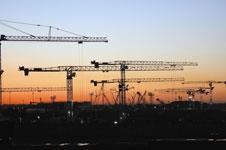Despite further falls in workload during Q3, outlook for the year ahead has finally turned positive
The RICS' latest construction survey has shown a further fall in workloads during the third quarter of the year, although the rate of decline appears to be slowing.
Moreover, optimism has begun to emerge about the prospects for the next 12 months, with more surveyors expecting workloads to rise than fall for the first time since the first quarter of 2008.
Profit margins are still expected to continue to fall over the coming year, however, and more jobs to be cut, although at a slowed rate.
Despite the continued fall in workloads, the net balance of surveyors reporting a fall rather than a rise activity narrowed to just 6%, which is the best reading since Q1 2008.
All sectors apart from the “other public works” category showed continued falls in activity but in every case the net balance was less negative than in the previous quarter.
The private commercial sector suffered worst, with 12% more surveyors reporting a fall rather than a rise in workload, but this was a big improvement on the negative reading of 41% in Q2.
In the private industrial sector, 10% more reported a fall rather than rise in activity levels, but this compared favourably with the negative figure of 39% in the previous quarter.
The public sector fared best, with the “other public works” category reporting a rise in workload for the second consecutive quarter, while in public housing the balance was only just negative.
Private housing's negative reading of 5% was its best outcome since the final quarter of 2007.
Despite the rise in optimism about workloads for the next 12 months, 38% more surveyors anticipate profit margins to fall further, and employment in the sector is also projected to decline, although more slowly.
At a regional level, Wales registered an increase in workloads, with a net balance of 17% of surveyors responding positively, compared with 1% in Q2. In London and the South-east the situation seems to have stabilised after five successive quarterly declines, but the rest of the country is still reporting declines.



























No comments yet